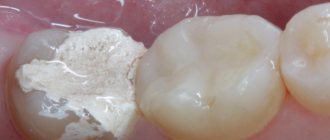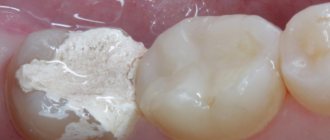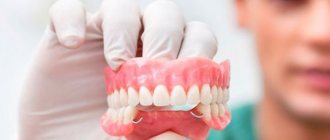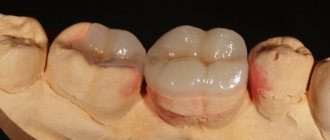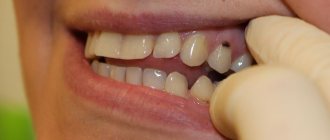- Prices
- Before and after
- Restoration with composite material
- Dental care after the procedure
The front or front teeth attract the most attention, so you want them to look perfect. But for one reason or another - over time, with age, as a result of illnesses, injuries, insufficient hygiene, an irrational lifestyle - changes occur that do not add to the attractiveness of the smile.
Patients turn to the dentist with various aesthetic problems:
- chipping of the cutting edge or even destruction of more than half of the dental unit;
- enamel defects (cracks, darkening, integrity violations);
- uneven shape of incisors, gaps between the front / chewing teeth, and other flaws.
In such cases, aesthetic restoration comes to the rescue. It helps to correct smile defects, restore its beauty, whiteness, and correct shape.
Dental restoration with composite materials.
Dentistry is actively developing every year; people’s eternal desire for everything beautiful has motivated specialists to create new, more advanced technologies for dental treatment and restoration. Over time, a new direction called aesthetic dentistry has emerged, which deals with these issues. It provides the opportunity to correct various cosmetic defects, and composite materials allow you to recreate the structure of the tooth, its anatomical shape and color. If filling only restores the functionality of the unit, then during its restoration the appearance is corrected. Let's talk in more detail about this unique technique.
What is composite restoration and when is it needed?
Composite materials in dentistry are usually called special mixtures of various polymer resins that harden under the influence of ultraviolet radiation or a chemical reaction. Composite restoration is the restoration of a partially destroyed tooth using such a composition.
The light-curing composite mixture is very plastic, so it can be molded into almost any shape. This gives dentists ample opportunities to restore teeth and makes the use of the mixture universal and applicable in many situations. In particular, composite dental restoration is carried out in the following cases:
- chipped part of a tooth;
- destruction of the tooth crown;
- death of the nerve inside the dental canal;
- the appearance of carious dentin damage;
- too large gaps between teeth;
- malocclusion;
- discoloration of enamel.
The procedure does not apply if:
- poor oral hygiene;
- bruxism;
- increased salivation;
- allergic reactions to composite materials;
- installed pacemaker (the composite can cause heart rhythm disturbances).
About the procedure.
The main objective of the cosmetic restoration procedure is to restore and adjust the size and shape of the tooth and also improve its appearance. With its help you can solve several problems:
- Easily eliminate the consequences of carious damage. During the treatment of caries, all infected tissues are drilled out, and in their place a cavity is formed, which must be filled with a filling. Thanks to composite materials, the defect can be corrected and the crown of the tooth can be successfully restored.
- Change the shade of enamel. Due to age-related changes, due to treatment and other things, the appearance of our smile noticeably deteriorates, and with the help of modern photopolymer materials you have the opportunity to return the natural shade of tooth enamel.
- Hide large interdental gaps. Composite restoration allows you to hide visible imperfections such as trema and diastema.
- Correct uneven units. During restoration, it is possible not only to eliminate cosmetic defects of the teeth, but also to correct some defects, for example, to give the desired shape to the front incisors. But before the procedure, you should definitely consult with an orthodontist, because... For serious pathologies, the only treatment option is braces.
- Fill in the missing part of the tooth. Due to injury or carelessness, a small piece of a person’s crown may break off. So that this deficiency does not cause inconvenience, it can be corrected by building up the missing part with a composite.
Cosmetic restoration is carried out using several methods, depending on what the patient wants and what problems he has, one of them is selected. To achieve an excellent effect, the A-medic clinic uses only high-quality composite materials, which allow you to achieve complete color similarity and look natural. This procedure is mainly used as the final stage of caries treatment; using a light-curing composite, the doctor restores the shape of the damaged tooth, recreating its crown part almost anew. This kind of work requires a professional who can take into account the anatomical features of the incisors, molars and canines and reproduce all the tubercles and irregularities on their chewing surface. If everything is done efficiently, the patient will not even be able to feel or touch the filling with his tongue.
Types of procedure
The choice of dental restoration technique depends on the individual characteristics of the clinical case. The following factors are taken into account: location of defects, extent, severity. Common types of restoration:
- Veneers. Restoration of the front teeth with composite material is carried out using veneers. They also come in ceramic, but such designs are much more expensive. Application is only possible for minor damage.
- Tabs. In this way, cavities formed in deep layers are closed. The technique is gradually losing its relevance, since the strength of such a restoration is not very high.
- Fillings. The installation is carried out regardless of the complexity of the clinical case. The most common and cheapest way, thanks to which it is easy to restore aesthetic comfort.
Contraindications.
Composite restoration, although it belongs to the section of aesthetic dentistry, is still a medical procedure and has a number of absolute contraindications. It cannot be performed if the patient is allergic to the materials used, has acute gum disease and has numerous caries. There are also several relative contraindications that should also be kept in mind:
- Destruction of tooth tissue by more than half.
- Absence of outer molars.
- Bruxism (teeth grinding).
- Abrasion of teeth.
- Malocclusion.
How does the procedure work?
Restoration of anterior and other teeth with composite materials consists of several stages:
- examination of a damaged tooth;
- turning to form clear boundaries of the restored area;
- if the pulp is being processed, install a special gasket to avoid burns from the composite;
- conditioning the tooth to remove fluid;
- formation of a bonding system that holds the composite;
- application of composite;
- irradiation of the light-hardening composite with ultraviolet light;
- checking the correctness of the bite;
- final processing and polishing.
Features of composite dental restoration.
Composite materials have been used in dentistry for over 50 years. And every year their quality improves, they become more reliable and durable. During the restoration process, the composite bonds to the surface of the tooth, strengthening and restoring its integrity. In some cases, when the crown is almost half destroyed, this restoration method is even preferable. It allows you to avoid depulpation (removal of the nerve) and the unit will not need to be ground down for an artificial insert.
Nowadays, almost all specialists have begun to use photo-curable materials in their work; with their help, you can achieve excellent aesthetic results. Of course, such structures as veneers, inlays and crowns greatly simplify the adjustment process; you just need to glue them on and your smile is already transformed. In the case of composite restoration, the dentist selects the appropriate shade of the material, carefully recreates parts of the damaged tooth, not forgetting about its features, tubercles and fissures. But even taking this fact into account, this aesthetic dentistry service has a number of advantages:
- The procedure is performed in one step.
- Reasonable price.
- Subject to the dentist's recommendations and proper care, the appearance of the restored teeth will remain for a long time.
- If the patient is not satisfied with the result, the restoration can be redone.
- Minimal grinding of healthy tooth tissue.
Progress of the procedure
There is no need to prepare in advance for artistic restoration using photo composites. If the direct technique is used, the reconstruction is completed in just 1 to 2 hours.
Stages:
- professional cleaning of plaque and stone, selection of composite according to enamel color;
- local anesthesia - carried out in case of preparation of dental tissues;
- drilling affected tissues (for caries), old fillings or grinding enamel for better adhesion;
- isolation from saliva, since moisture is unacceptable when applying composite materials;
- surface etching;
- layer-by-layer application of light-curing material of different shades and transparency gradients to imitate natural enamel;
- drying each layer with an ultraviolet lamp;
- grinding (grinding off excess) to form an ideal shape and fit the bite;
- polishing for smoothness.
If the coronal part is severely damaged, then a pin is installed, which supports the structure and makes it more stable. The pins are made from titanium or fiberglass, as regular metal rods can show through and impair aesthetics. However, a better restoration in this case involves the installation of inlays or crowns.
With the indirect method, the veneer or inlay is installed in two stages. The first stage involves preparing the tooth and taking impressions. The restoration components are manufactured in a dental laboratory. At the second stage, the overlays are fixed with cement paste.
Methods of dental restoration.
In dentistry, there are two options for aesthetic restoration. The indirect method is used in more complex cases where it is necessary to restore severely damaged units and correct serious cosmetic defects. In this case, the whole process is extended over several appointments: first, the doctor conducts an examination and takes impressions, and then sends them to the laboratory where the restoration elements will be made. Another technique is direct restoration, which involves the use of composite materials. All manipulations are carried out directly in the patient’s mouth, in the dentist’s office. Sometimes the procedure can last several hours, which causes discomfort for the patient. In case of more significant chips and destruction of the unit, to strengthen it and to secure the filling well, a pin is installed in the root canal.
Stages of composite restoration.
Let's take a closer look at the stages of direct dental restoration.
- Preparatory.
To begin with, the dentist will conduct an examination, assess the condition of the teeth and gums, and, if necessary, prescribe oral sanitation. In order for the color of the restored area to be identical to the natural one, it is necessary to clean the teeth of plaque and stone. Only after this can a specialist correctly determine the appropriate shade of the composite.
- Cleansing.
For a painless procedure, the patient is given an injection with anesthetic drugs. After the anesthesia begins to take effect, carious tissue, remnants of old fillings and other contaminants that may cause poor contact between the photopolymer and the crown are removed from the surface of the tooth.
- Tooth shape modeling.
The filling material is applied in layers, the dentist combines different shades of the composite, creating a natural shade. At the same time, he tries to recreate the appearance of a natural tooth, taking into account its anatomical features. At the end of the procedure, the chewing surface of the unit is polished and ground so that nothing disturbs the patient.
Restoration of chewing teeth –
In videos 3 and 4 you can see how the restoration of chewing teeth is carried out with composite filling material. In video 3, the restoration can hardly be called “artistic”, because... The chewing surface of the tooth with all its fissures was restored only “satisfactorily”. However, this video does a good job of showing the restoration of the side walls of the tooth and the contact points between the teeth. Video 4 shows the final stage of a truly artistic restoration.
Recommendations for care.
As soon as the specialist completes his work, you will be able to admire your irresistible smile, without any cosmetic defects. To maintain the results obtained for many years, you must follow a few simple rules. Their implementation will not be difficult for you at all, but at the same time your teeth will remain intact.
- Eliminate food and drinks containing dyes from your diet for a day after the procedure. In the future, also try to avoid consuming highly colored foods, carbonated water, red wine, coffee, etc.
- Don't forget about regular dental checkups and professional oral hygiene.
- On the first day after restoration, women should not wear bright red lipstick.
- The restored areas of the teeth may not withstand heavy loads, so you should not bite seeds, nuts, or chew sticky food.
- Use a toothbrush with soft bristles; it will avoid rapid abrasion of the filling material.
Combining direct and indirect techniques
Complete rehabilitation of a patient with significant tooth decay
In modern dentistry, there is a tendency to combine direct and indirect techniques. Figure 6 shows a 12-year-old boy with hypoplastic amelogenesis imperfecta and loss of lower facial height. The treatment plan included raising the occlusal height using a combination of direct composite restoration and indirect veneers, as well as composite crowns in a modified three-step and sandwich technique. 7 Thanks to the use of a composite, treatment can be non-invasive. This material also requires a minimum layer thickness.
After the initial consultation, orthodontic treatment was performed to correct the crossbite. Due to the expected growth of the TMJ, conservative therapy began at the age of 11 years. In this case, raising the bite height/lower facial height required a pathological lower bite.
The goal of orthodontic treatment was also to create sufficient proximal and interdental space for further restoration. It was necessary to raise the bite by 3 mm. After impressions were taken, a diagnostic waxup of the anterior and posterior teeth was created to plan and monitor treatment. An orthodontic splint was created for adaptation to the new occlusion height. Treatment plan:
- Posterior teeth: 16 indirect composite crowns for teeth 14-17, 24-27, 34-37, 44-47
- Lower anterior teeth 33-43: 6 indirect composite veneers vestibular and lingual
- Maxillary anterior teeth 13-23: 6 direct labial composite veneers and 6 indirect palatal composite veneers (Figure 6c)
Composite crowns were laboratory fabricated from SR Adoro (Dentin A3, Enamel TS2; Ivoclar Vivadent), a veneer composite with a good history of clinical use. 8,9 Treatment was carried out for 1 week. During the first visit, 16 composite crowns (Tetric EvoFlow A3, Ivoclar Vivadent) were adhesively cemented. Due to the raised bite, an open bite was formed in the anterior region. The patient was explained that biting food with the front teeth would be impossible for a week. After one week, the lingual composite veneers were cemented (Figure 6d). The labial surface was restored by the dentist using a direct layering technique of composite (Enamel Plus HFO, UD3.5, Enamel GE2; Micerium; Fig 6e). On the third visit a day later, the same procedure was performed in the frontal region of the lower jaw. At the follow-up visit after 2 months, the clinical situation was aesthetically satisfactory (Figure 6f - 6i).
Fig. 6a 12-year-old boy with amelogenesis imperfecta: smile before treatment Fig. 6b State of the oral cavity before treatment. Fig 6c Palatal composite veneers on the upper front teeth of the jaw and composite crowns on the chewing teeth. Fig. 6d After cementation of palatal composite veneers and composite crowns on posterior teeth. Fig. 6f Direct composite build-up/direct composite veneers on maxillary anterior teeth made of Enamel Plus HFO.
The application of occlusal composite overlays in the lateral region to raise the bite is described in the literature. To create a new height in the lower part of the face, so-called composite overlays are used. 10 They are based on a minimally invasive, location-specific hard tissue defect concept. In the described case, due to the age of the patient and the lack of space, composite restorations were the most preferred. Other cases in which this technique was used (for example, with molar-incisal hypomineralization) also showed good clinical results. If the restoration subsequently chips due to jaw growth or functional wear, it can be restored intraorally. Surface gloss should be observed to maintain color stability.
Fig 6f - 6i Stability of the restoration after treatment. (f) Upper jaw. (g) Lower jaw. (h) Oral condition after treatment (i) Smile after treatment.
Replacement of a lost tooth (due to trauma/aplasia) with a composite fixed prosthesis reinforced with fiberglass (adhesive bridge on a fiberglass beam)
When one front tooth is lost and space needs to be preserved, adhesive composite bridges on a fiberglass beam have been successfully used. Figure 7 demonstrates the replacement of a single lost tooth in the anterior region, when implantation is impossible due to the small interroot space. Composite fiberglass bar bridges provide satisfactory esthetics and appear to be an alternative to all-ceramic bridges. Evidence in the literature suggests good results, and such glass fiber-reinforced adhesive bridges could become an option alongside implantation and prosthetic restorations.
The patient in Figure 7 was referred to an orthodontist because of a compromised right lateral incisor. The remaining root was also affected, which means orthodontic extrusion was undesirable and the tooth was removed. The patient refused orthodontic treatment to expand the interdental space, which would facilitate implantation, so implantation was abandoned. After removal, a temporary bridge was fixed. It was then possible to install an adhesive composite bridge on the fiberglass beam.
Fig 7a-7d Restorative treatment of missing tooth 12 using an adhesive composite bridge on a fiberglass bar. Fig. 7a Clinical situation at the initial consultation: compromised tooth 12 and provisional crown. Fig. 7b State after extraction, creation of a provisional bridge. Figure 7c Before fixing the adhesive composite bridge to the fiberglass beam. Figure 7d After cementing the adhesive composite bridge onto the fiberglass beam.
Vallittu11 reported 75% Kaplan-Meier survival after 63 months, and Freilich et al12 reported 74% survival after 3.75 years. In a retrospective study by Wolff et al13, only 1 of 32 adhesive composite fiberglass beam bridges examined failed after 18 months (USPHS/Ryge-criteria).
How much does the procedure cost?
The cost of the procedure depends on its complexity and the materials used. Before restoring you must:
- Carry out professional cleaning in the clinic - remove tartar and soft plaque.
- Fill the caries lesions.
- If there are signs of periodontal inflammation, carry out the necessary therapy.
The more serious the treatment, the more expensive the set of procedures will be. If plates or inlays are placed on carious, plaque-covered units, the infection will continue to develop. This means that the situation will rapidly deteriorate. After just a few months, the veneers and inlays will have to be removed in order to cure the diseased unit.
Perfect smile without pain
Even healthy teeth can look unattractive. The enamel turns yellow, cracks or chips appear on it. Artistic dental restoration carried out by specialists at Dr. Granov’s clinic will return radiance and whiteness to your smile.
The dental center is located in Moscow, in the South-Western Administrative District, near the metro stations “Profsoyuznaya” and “Novye Cheryomushki” and “University”.
Dental restoration at Dr. Granov’s clinic
Veneers, lumineers and inlays. Competent doctors and affordable prices.
Leave your phone number. The clinic administrator will call you back.
By leaving a request on the site, you consent to the processing of personal data
Make an appointment
Dentist consultation
400 rubles
Material
Composite dental restoration and the success of the procedure depend not only on the quality of the substance selected, but also on the correct use of the adhesive material and the light supply system for hardening the filling. Therefore, if the dentist makes a mistake during the procedure or changes the course of action, side effects or the filling may fall out.
The use of composite resins as a filling material has many advantages. Thus, a large number of classifications determines the different composition and types of composites.
The following types of composite are distinguished:
- standard - the disadvantage of this type is a large number of aesthetic defects after tooth restoration, as well as the difficulty in achieving tooth shine after installing the material;
- Fine-grained composite - the disadvantage is the ability to withstand only small loads;
- Hybrid composites have virtually no disadvantages. This is due to the presence of large substances in the chemical composition that ensure strong attachment. Such products have a good aesthetic effect and shine.
Despite the variety, dentistry more often uses traditional material because it is cheap and available.
